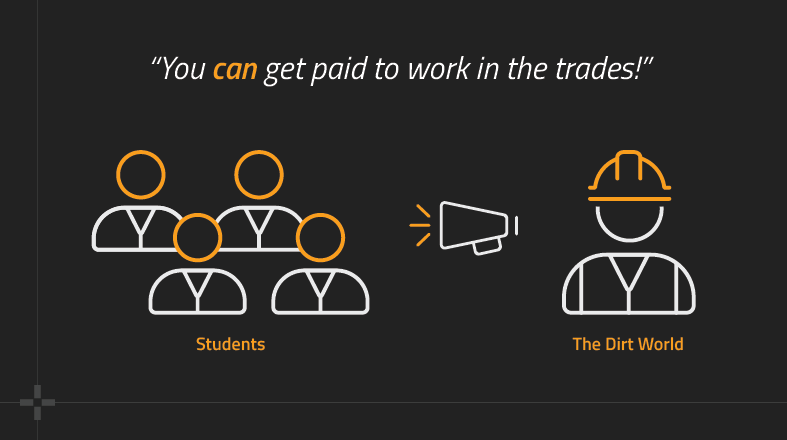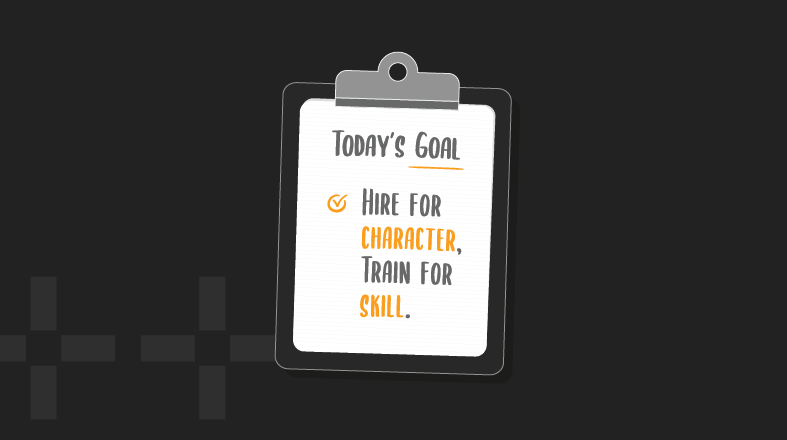Recruit From a Bigger Hiring Pool
Written by Megan Hamilton
June 28, 2022

Working in the Dirt World takes skill and the right attitude. You can't turn just anybody loose with a half-million dollar machine. You need someone who can do the work and work well with others.
But when most people aren't a fit for your business, they aren't the problem. Your recruiting strategy probably is. When you narrow your recruiting pool down too much, you miss the great talent that's available.
We’ll share how you can expand your recruiting pool to attract the next generation of workers. But first, let’s dig deeper into the recruiting problem.
How many eligible candidates are there?
Better question: how many eligible candidates does the industry need?
Around 7.9 million people worked in construction in early 2023.1 Other Dirt World sectors like mining and utilities employed another 1.2 million.2,3 That made up about 3% of our nation’s workforce—not exactly the majority of workers.4
It just takes a few (million) good people to keep the industry running. And with over 3.5 million students graduating from high school each year, warm bodies aren’t in short supply.5 It should be pretty easy to get people into the Dirt World.
Yet experts predict as many as 1.9 million openings for skilled craft professionals by 2025.6 And with the average age of construction workers increasing from 37 in 1994 to 43 in 2020, it’s safe to say that young people are not entering this industry at a high rate of speed.7
Where’s the disconnect? And how do you get enough people into the Dirt World to fill the gaps retirees leave behind?
We’ve talked about seven reasons the industry has a people problem, and one reason is recruiting from too small of a talent pool. Let’s look at how you can overcome this challenge.
Stop believing the myth that kids today don't want to work
Randy Blount and Jason Schroeder have decades of experience in the construction industry, and they have something to say to people who complain that kids today don’t want to work:
“Every one of you is a parent to the generation you say don't know how to work hard. So either they do, because all of you know how to work hard. Or you guys failed at teaching them how to work hard. I think the latter is not the case. They do know how to work hard, but their values are different.” - Randy
“There's no difference in the hard-workingness of the people nowadays as they were 15 or 20 years ago. They bust their butt. It’s not that people don’t want to work. It's that they don't want to work for you.” - Jason
Today’s generation values having a mission and a purpose—not just a paycheck. And they want to work for companies that have a healthy, respectful culture.
Your business probably is one of those companies. Kids just don’t know that. Which brings us to . . .
Start telling the real story

Young people must learn about the trades as great career options after high school.
Unfortunately, many schools no longer offer vocational arts classes like wood shop or small engine repair, so students don’t learn about machinery or working with their hands.
And many parents see the Dirt World as filthy, dangerous, and “not good enough” for their kids. In fact, the National Asphalt Paving Association (NAPA) found that 42% of community members had unfavorable views of paving.8
However, when NAPA shared positive messages about paving, people began viewing the industry more favorably. They became 20% more likely to recommend a career in road construction to young people—and 17% more likely to consider starting their own career in paving!9
The point is, people already have opinions about what they think you do. So, will you let misinformed people stereotype your trade as dirty and undignified . . . or will you set the record straight? Will you teach them what a powerful, meaningful mission they and their kids can be part of?
If so, it's time to get your company on social media—where the kids are—and show them how cool a career in this industry is. Show them how a career with your company can benefit them and their community.
How to tell your story
Some simple ways you can do that are:
- Post photos of your jobsites and equipment so people can picture themselves working in that environment
- Spotlight your current employees so kids can “meet” people who are already in the industry and imagine joining them
- Share success stories from clients or charity work your company has done so people can see how they can give back to their community when they work for you
When people can visualize themselves on a jobsite, in a machine, working alongside one of your employees, or giving back to their community, they’ll be much more interested in working for you.
And if those people happen to be kids, they’ll convince their parents it’s the right career choice. (After all, if you have kids you know how persistent they can be!)
Hire people who have no experience

Like, no experience. Zero. Zip. Zilch. Nada. Goose egg.
Loads of people would love to work with their hands, have outstanding character, and would make this industry and your company better. But they're not doing it because you only want to hire someone with two, five, or 10 years of experience.
That’s a big problem—for you and for them. It takes up to 12 years to fully train someone as a construction craft professional, so it'll be a decade before new hires reach the same skill level as people who are currently retiring.10
You need people now. What are you supposed to do for 12 years while they gain experience? And how will they gain experience if you won’t give them a chance?
Being willing to hire inexperienced people opens all kinds of doors. It helps you:
- Create paths into the industry
- Give people entry-level starting points as a foundation for their careers
- Train new hires to do the work the right way
- Free up your experienced crew members to handle the more intense work
- Promote your experienced crew members who’ve worked hard to get where they are in their careers
Another thing to keep in mind: High school students may be the future, but they aren’t the only ones seeking employment. Many people switch to a career in the trades in their 30s, 40s, and even 50s—after years of developing their character and work ethic elsewhere.
These people have valuable skills that you want in the field like leadership, communication, and organization. So while they may not have experience in your industry, they do have plenty of experience that can make them great workers.
Train the people when you get them

Based on what workers have told us, the Dirt World is currently lacking when it comes to training. Nearly half of workers get training once a year or less—and around 10% never get any training!
Thankfully, leaders like you can change this situation. When you have a training plan in place, you can get new hires up to speed safely and start helping them develop their careers on day one.
If you don’t have a training plan, now’s a great time to start. Think about questions like:
- How will you turn that kid who's never held a shovel into a good laborer?
- How will you help them become an operator?
- What about that guy who's 35 and came from tech—how will you teach him about the heavy civil industry?
Your new hires may be able to figure out some of that stuff on their own. But if you want them to get up to speed faster and perform better, you need to teach them the technical and interpersonal skills to succeed in their roles.
Plus, there’s another reason to offer training: recruits are actively looking for it.
Recruits are looking for companies that will train them
People want training. They want to work for companies that will invest in them and contribute to their professional and personal growth. In other words, they want to learn.
And here’s what they have to say about workplace learning:
- Learning opportunities are the second-most inspiring thing about people’s jobs (right after the work itself).11
- One in five people say they’d quit their job if they didn’t have chances to learn.12
- Training is one of the top three things construction workers want in a workplace.13
- Since the COVID-19 pandemic, 89% of Americans say they would learn a whole new set of skills so they could get a new job.14
Think about that! Most people are willing to learn new skills so they can work in a new trade—and for some, that includes ditching their desk for the Dirt World.
When you have a training plan in place, you can tell recruits, “Hey, come work for me and I’ll train you.” That’s a huge deal to them, and it’ll expand your recruiting pool exponentially.
You’ll just need to be ready to deliver when they get there.
Whether you create your own training program or purchase training software to help you out, you can give recruits—and your current employees—the training they crave.
Want help leveling up your training program and your people? Get the free guide to training for retention and recruitment.














